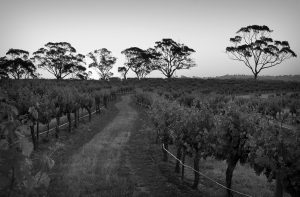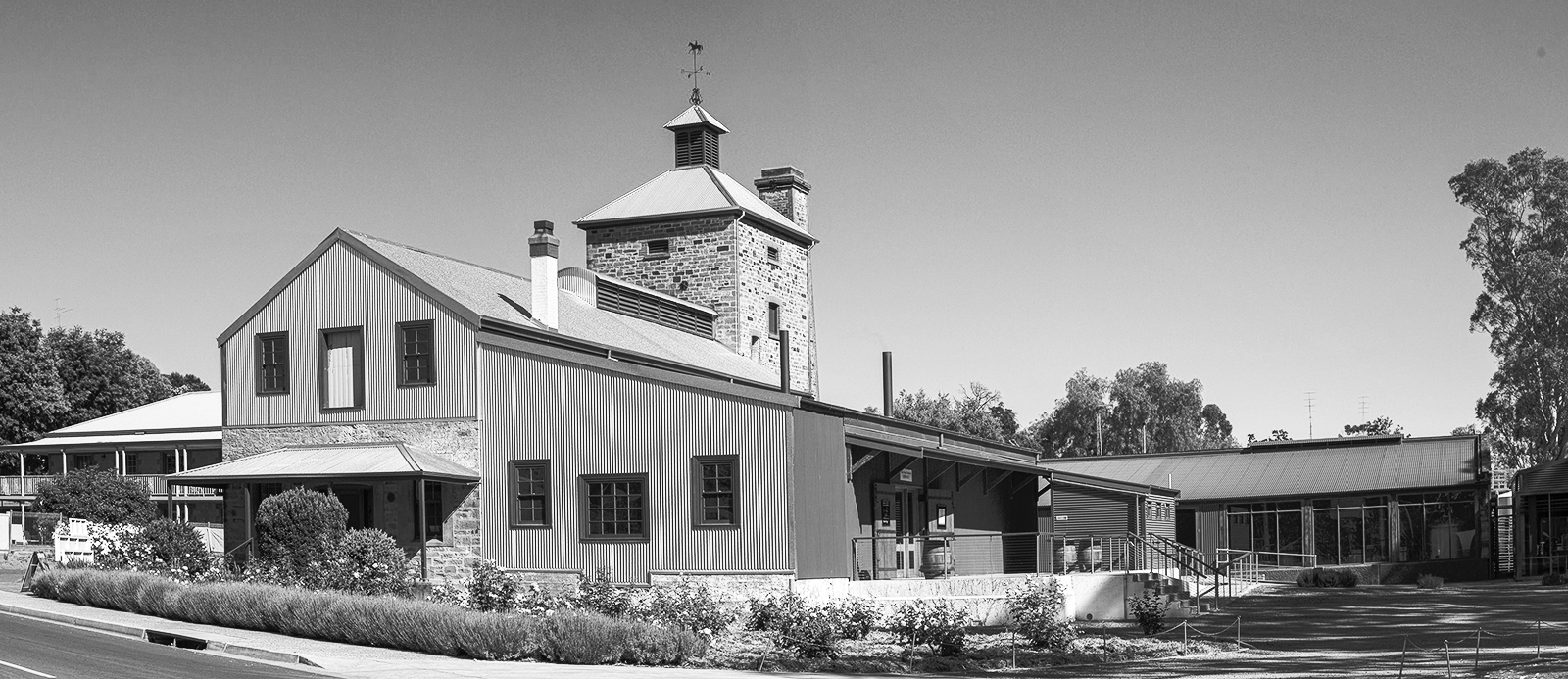 ‘There are two kinds of people: those who were born in Clare and those who wish they were born in Clare’ – Tim Knappstein
‘There are two kinds of people: those who were born in Clare and those who wish they were born in Clare’ – Tim Knappstein
CLARE VALLEY
Clare was founded by an extraordinary Englishman, John Horrocks, who established Hope Farm in 1840. Although he was responsible for planting the first vines, it was mineral wealth that formed the first surge in population. Copper was discovered here in 1845 but when the ore was depleted, it was replaced with a boom in cereal planting, creating wealth in the district in a very short time. Later, in the second half of the 1800s, high quality slate was mined at Mintaro and silver was discovered at Broken Hill.
Vineyards and wineries were to follow. Sevenhills planted its first vines in 1852. By 1897 there were 580 hectares of vines in the ground, although world events slowed the growth in plantings during the first half of the 20th Century.
The valley runs on a fifty kilometre north-south axis at an average elevation of 400 metres. The highest vineyards are at Mount Horrocks, planted at 580m. Although the vineyards appear to run contiguously, the region is split into six individual sub-regions: Clare (at the north), Sevenhill, Watervale (the most recognised for the quality of its Rieslings), Leasingham, Auburn and Polish Hill River.
 Climatically, Clare is something of a paradox given it is seemingly so warm, yet the region is best associated with one single cool climate grape variety: Riesling. Over 60% of the annual rainfall is between May and September, when the wines are dormant. With a mere 200mm of rain during the growing season irrigation is desirable, even if there is an absence of ground water which makes this a challenge and vines have traditionally been grown using dry land farming techniques. Low humidity ensures that fungal infection is seldom an issue, but the lack of water can be responsible for stress towards the end of the growing season with defoliation of the vines leading to ripening issues.
Climatically, Clare is something of a paradox given it is seemingly so warm, yet the region is best associated with one single cool climate grape variety: Riesling. Over 60% of the annual rainfall is between May and September, when the wines are dormant. With a mere 200mm of rain during the growing season irrigation is desirable, even if there is an absence of ground water which makes this a challenge and vines have traditionally been grown using dry land farming techniques. Low humidity ensures that fungal infection is seldom an issue, but the lack of water can be responsible for stress towards the end of the growing season with defoliation of the vines leading to ripening issues.
Soils are complex, due to the considerable variation in aspect and slope. Essentially, the region is made up of sandy loam which lies over a calcareous subsoil.
Riesling by far is the most widely planted variety. Along with Eden Valley, it is arguably the source of Australia’s finest examples. Typical Clare Riesling starts out life as an austere and somewhat thin wine, but after a few years in bottle, they tend to fatten out and show much greater complexity. These are long-lived wines. Only the poorest vintages won’t age more than five to ten years. The best examples will last beyond two decades; one just needs to be patient.
Riesling is almost always the last variety in Clare to be harvested.
To qualify as ‘dry’ Riesling, the wine needs to be less than 9g/l of residual sugar with a corresponding acidity of 9g/l.
Local valley legend suggests that every vintage ending with a ‘2’ is destined to be a great year in both the Clare and Eden Valley’s. The 2012 was certainly hailed as South Australia’s finest Riesling vintage since 2002. Could 2022 trump either of these…? Quoting Stephen Henschke: ‘Looking back at the ’62, ’72, ’82, ’92, 2002 and 2012, all the ‘twos’ look like great vintages’.
Cabernet Sauvignon is the other grape variety recognised within the region, although there are those who believe Shiraz grown in Clare is equally as good. The compromise is to blend the two, often with the addition of a little Malbec. Most of the red grape plantings appear to be at the northern end of the valley, closer to the town of Clare itself.
KNAPPSTEIN
Tim Knappstein joined the Stanley Wine Company in 1969, working his apprenticeship for a company who was a significant player in Clare during this time.
However, in the mid-1970s he left SWC and created Tim Knappstein Wines, locating his winery in what was once the Enterprise Brewery at the northern end of the Clare town. Built in 1878, the brewery’s primary purpose was to quench the thirst of local miners. The building went through various charges, having renamed the Clare Brewery in 1905. That went out of business in 1917 after semi-prohibition laws restricted opening hours for the sale of alcohol. After the war, it became the home of Clare Mineral Waters, before the Knappstein family took over the property in 1976 and initially christening it the Clare Enterprise Winery. Today it is simply known as the Knappstein Enterprise Winery.

Tim Knappstein was instrumental during that period in establishing the Clare Valley as one of Australia’s premium wine growing regions, not only with the quality of his Riesling, but with his Cabernet Sauvignon too.
Since then, it would be fair to say that the winery has passed through various hands over the years, including a period under the ownership of Wolf Blass, however each subsequent proprietor has elected to maintain and respect the Knappstein name. Today, the winery is under Chinese ownership with current winemaker. Michael Kane, relocating from Margaret River to take up the position in 2019.
Despite the changes, the wines have always been sourced exclusively from the same estate owned vineyards, with a total of 130 hectares planted through the Clare Valley.
The three main grape varieties grown are Riesling (around 30% of total plantings), Shiraz (around 35%, which echoes total plantings in the region) and Cabernet Sauvignon (around 30%). Other varieties include Chardonnay, Grenache, Pinot Gris, Sangiovese and Malbec. The latter has always been a feature within Clare Valley, with most producers planting a few rows to help add structure and body to their red wines.
THE WINES
CLARE VALLEY RIESLING
This comes from a variety of different vineyards located throughout the valley. Vines age ranges from 10 to 30 years. Vinification is somewhat conventional for all the Rieslings produced at Knappstein. Spending the first three months in stainless steel, after having been fermented with the aid of neutral yeast strains. Fermentation is cool and long, leaving the wine with around 3-5g/l of residual sugar.
The 2022 growing season started wet, with record rainfalls in November 2021. Dams were full and there were good levels of moisture in the soil, offering positive conditions through flowering and fruit set. Cool conditions during January and February provided long and steady ripening conditions, perfect for developing long-term complex wines. It’s probably still too early to tell whether this vintage will follow in the ‘legend of the twos’…
ACKLAND RIESLING
The unique terroir of the Ackland vineyard is responsible for the most celebrated of the Knappstein Rieslings. The vineyard is located at Watervale on fertile red loam set over limestone subsoil with large pockets of slate scattered throughout. The combination of vine age (the vineyard was planted in 1971), complex soils and an elevation of between 420-450 metres, there is often quite dramatic diurnal temperature shifts in the summer months, which helps to ensure the retention of naturally high acidity levels). Ackland produces elegant wines, which are always considered an annual benchmark for the region.
A cool dry winter and a hot start to summer suggested the 2022 harvest would be a tricky one. Welcome rain at the start of February helped to keep the vines sustained. Grapes in Ackland were harvested in the third week of February.
ENTERPRISE RIESLING
Situated some 20km further north of the Ackland Vineyard, the Enterprise site is slightly warmer and located on the Clare Valley’s famous terra rosa soil over limestone. It is, however, usual to pick this site within a day or two of Ackland. This richer, warmer site delivers a broader, richer expression of Riesling.
CLARE VALLEY CABERNET SAUVIGNON
The grapes for this wine are grown on the Yertabulti and Provis vineyards, situated at the northern end of the Clare Valley and considered by the winery to be the perfect climate for maturing premium red grapes.
CLARE VALLEY CABERNET MALBEC
This is a blend of 80% Cabernet Sauvignon and 20% Malbec. Malbec has always been an important component in Clare red wines, since it helps give depth and structure to blends. The fruit also comes from the Yertabulti and Provis sites at the northern end of the valley.
The growing conditions in 2021 saw some good rain events towards the end of winter and into the start of spring, providing a good start to the growing season. The wine is matured in 300 litre hogsheads, with a proportion kept in tank to add some freshness.
MAYOR’S VINEYARD SHIRAZ
This single vineyard site, a combination of terra rosa and slate, is situated at just over 500 metres elevation north-east of Clare. These low-yielding vines exceeding fifty years of age. The blocks are harvested and vinified separately. After a ten-day ferment in stainless steel, the wine is transferred into 500 litre French oak barrels and left to mature for 14 to 16 months. Around 20% of these hogsheads and new.
The wine is not produced as a single release every year. Prior to 2019 and 2020, the previous vintage was 2015. It takes its name from the fact that the site was once owned by a former mayor of Adelaide.
ENTERPRISE SINGLE VINEYARD CABERNET SAUVIGNON
The low-yielding Cabernet vines of this vineyard bear fruit on the iron-rich terra rossa and limestone subsoil. Planted in 1969, the calibre and typicity of the vineyard has shone through consistently over time and now is the source of the Single Vineyard Knappstein Enterprise Cabernet Sauvignon. It remains one of the pinnacle examples of Clare Valley Cabernet.
www.knappstein.com.au
| Ackland Riesling | pack shot | fiche 2022 |
| Enterprise Vineyard Riesling | pack shot | fiche 2022 |
| Clare Valley Riesling | pack shot | fiche 2022 |
| Clare Valley Shiraz | pack shot | fiche 2021 |
| Clare Valley Shiraz | pack shot | fiche 2020 |
| Clare Valley Cabernet Sauvignon | pack shot | fiche 2020 |
| Clare Valley Cabernet Sauvignon / Malbec | pack shot | fiche 2021 |
| Enterprise Vineyard Cabernet Sauvignon | pack shot | fiche 2019 |
| The Mayor’s Vineyard Shiraz | pack shot | fiche 2020 |